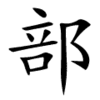部
| ||||||||
Translingual
| Stroke order | |||
|---|---|---|---|
 | |||
Han character
部 (Kangxi radical 163, 邑+8, 11 strokes, cangjie input 卜口弓中 (YRNL), four-corner 07627, composition ⿰咅阝)
Descendants
- へ (Hiragana character derived from Man'yōgana)
- ヘ (Katakana character derived from Man'yōgana)
References
- KangXi: page 1272, character 17
- Dai Kanwa Jiten: character 39460
- Dae Jaweon: page 1771, character 12
- Hanyu Da Zidian (first edition): volume 6, page 3780, character 9
- Unihan data for U+90E8
Chinese
| simp. and trad. |
部 | |
|---|---|---|
| 2nd round simp. | 𰆊 | |
Glyph origin
Characters in the same phonetic series (咅) (Zhengzhang, 2003)
| Old Chinese | |
|---|---|
| 蓓 | *bɯːʔ, *bɯːʔ |
| 倍 | *bɯːʔ |
| 菩 | *bɯːʔ, *bɯʔ, *bɯː, *bɯːɡ |
| 掊 | *bruː, *poːʔ, *bɯ, *bɯ |
| 剖 | *pʰoːʔ, *pʰoʔ |
| 婄 | *pʰɯʔ, *bɯʔ, *bɯː |
| 踣 | *pʰɯs, *bɯːɡ |
| 箁 | *bɯ |
| 咅 | *pʰɯʔ, *pʰl'oːs |
| 部 | *boːʔ, *boːʔ, *boːʔ, *boːʔ |
| 培 | *boːʔ, *bɯː |
| 犃 | *boːʔ |
| 瓿 | *boːʔ, *bɯ, *bo |
| 殕 | *pɯʔ, *pʰoʔ, *qɯːɡ |
| 醅 | *pʰɯ, *pʰɯː |
| 棓 | *bɯ, *broːŋʔ, *bɯː |
| 涪 | *bɯ |
| 賠 | *bɯː |
| 陪 | *bɯː |
| 毰 | *bɯː |
| 焙 | *bɯːs |
Phono-semantic compound (形聲, OC *boːʔ, *boːʔ, *boːʔ, *boːʔ) : phonetic 咅 (OC *pʰɯʔ, *pʰl'oːs) + semantic 邑.
Pronunciation
Definitions
部
- part; division; section
- department; ministry
- (historical) An administrative division governed by a ministry.
- Classifier for works of literature, films, machines (cars, telephones...), etc. ⇒ all nouns using this classifier
Synonyms
Dialectal synonyms of 輛 (“(classifier for vehicles)”) [map]
Dialectal synonyms of 架 (“(classifier for airplanes)”) [map]
Compounds
Derived terms from 部
|
|
|
Japanese
Readings
Compounds
Compounds
- 部長 (buchō, “division head”)
- 部門 (bumon, “division, group, branch”)
- 部屋 (heya, “room (of a house, apartment or hotel)”)
- 細部 (saibu, “details”)
- 全部 (zenbu, “everything, all”)
- 部活動 (bukatsudō, “extracurricular activities; club activities; school club”)
- 内部 (naibu, “interior, inside, internal”)
- 外部 (gaibu, “exterior, outside, external”)
Suffix
部 • (-bu)
Usage notes
This is a level higher than -課 (-ka, “department”), since for example 部長 (buchō, “division head”) is the boss of a 課長 (kachō, “department head”).
See also
- 部活動 (bukatsudō)
Vietnamese
Han character
部: Hán Nôm readings: bộ, bõ, bỏ
- This term needs a translation to English. Please help out and add a translation, then remove the text
{{rfdef}}.
Usage notes
The Hán pronunciation is "bộ" :
- part; division; section : 部分 bộ phận=part
- ministry: 部長 bộ trưởng = minister
- classifier
The Nôm pronunciations "bõ", "bỏ", "bọ" are derived from the Hán pronunciation "bộ"
This article is issued from Wiktionary. The text is licensed under Creative Commons - Attribution - Sharealike. Additional terms may apply for the media files.